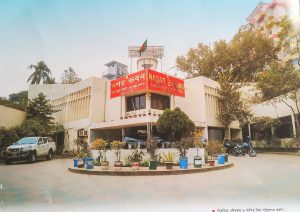Urban Growth and Citizen Care: How Comilla City Corporation is Shaping a Livable, Inclusive, and Future-Ready City
- Badrul Huda Jenu, President, Multiparty Advocacy Forum, Cumilla. & Former Manager, Bangladesh National Cricket Team

In the landscape of rapidly urbanizing Bangladesh, Comilla stands as a unique city—rich in heritage, vibrant in culture, and strategically located between the capital Dhaka and the port city of Chattogram. As Comilla transforms into a modern urban hub, its governance needs are evolving just as swiftly. At the heart of this transformation is the Comilla City Corporation (CuCC)—an institution that balances infrastructure development with deep commitment to public service.
This article explores the dual narrative of urban growth and citizen care as navigated by Comilla City Corporation. From smart infrastructure and digital governance to health, sanitation, education, and environmental responsibility, we examine how CuCC is forging a city that is not only growing, but growing for its people.
The Rise of Comilla: A City in Transition
Founded as a City Corporation in 2011, Comilla’s urban trajectory has accelerated over the past decade. With a population crossing half a million and expanding economic activities, the city now faces the dual challenge of modernizing its urban infrastructure while preserving its historical identity.
What makes Comilla’s case particularly noteworthy is its location as a transport and education hub, its dense neighborhoods and water-centric landscape, and the delicate balance between rapid urbanization and sustainable governance. It’s here that Comilla City Corporation emerges not just as a regulatory body, but as a catalyst for transformation.
Vision and Leadership: Governance That Puts Citizens First

At the core of Comilla City Corporation’s approach is a vision rooted in people-first governance. Under the leadership of its Mayor and Chief Executive Officer, the Corporation has adopted a multi-pronged development strategy based on the following pillars:
- Integrated urban planning
- Smart public service delivery
- Environmental sustainability
- Inclusive civic participation
The motto guiding these efforts is simple but powerful: “People are at the center of the city’s progress.”
Urban Growth: Building the Physical Backbone of a Modern City
- Infrastructure Development
Comilla City Corporation has launched and completed multiple road expansion, renovation, and pavement projects. With over 300 kilometers of roads within its jurisdiction, the Corporation has prioritized:
- Widening and re-asphalting key roads
- Building pedestrian footpaths and overpasses
- Installing smart LED streetlights
These projects not only enhance transportation but also contribute to road safety and urban aesthetics.
- Drainage and Water Management
Historically vulnerable to waterlogging and flash floods, CuCC has invested in:
- Reconstructing canal networks
- Upgrading stormwater drainage systems
- Integrating digital flood mapping technologies
Restoring the Old Gomti River and adjoining canals, inspired by Dhaka’s Hatirjheel model, is a visionary project currently in planning, aimed at boosting both ecological balance and urban beauty.
- Urban Housing and Zoning
The Corporation is updating land use maps and enforcing zoning regulations to prevent haphazard development. It has proposed:
- Affordable housing for low-income families
- Urban renewal plans for older wards
- Public building compliance checks
Citizen Care: Service Delivery with Dignity

While infrastructure drives growth, it is civic services that touch people’s lives every day. Comilla City Corporation has made significant progress in:
- Health and Sanitation
Public health is a priority. CuCC operates mobile health units and community clinics, especially in underserved wards. Efforts also include:
- Dengue prevention campaigns and mosquito fogging
- Regular water quality testing
- COVID-19 vaccination and awareness drives
Sanitation services have expanded to include:
- Door-to-door waste collection
- Introduction of community waste bins
- GPS-tracked garbage trucks
Plans for waste-to-energy conversion and recycling cooperatives are underway.
- Education and Libraries
CuCC manages and supports several primary schools, aiming to improve literacy and inclusion. Current initiatives include:
- Teacher training and curriculum updates
- Digital classrooms pilot programs
- Support to underprivileged students with uniforms and meals
The revival of the Comilla Public Library project, including plans for a digital archive and youth reading rooms, represents the city’s dedication to lifelong learning.
- Digital Governance and E-Services
Embracing ICT, Comilla City Corporation has digitized numerous services:
- Online birth and death registration
- Holding tax assessment and payment portal
- App-based citizen complaint system
These initiatives reduce corruption, improve efficiency, and bring services closer to residents—especially those who previously faced barriers due to mobility, education, or income.
Inclusivity in Governance: Leaving No Citizen Behind

Empowering Women and Vulnerable Groups
CuCC has ensured women’s representation through reserved councillor seats and gender-focused service programs. Female participation is growing in:
- Urban planning sessions
- Health awareness campaigns
- Leadership roles in waste and education projects
There are ongoing proposals for safe shelters for women, gender-inclusive toilets in markets, and maternity healthcare access in every ward.
Youth and Civic Innovation
Recognizing youth as both digital natives and changemakers, CuCC has:
- Launched volunteer programs in waste management and health campaigns
- Partnered with local universities for urban research and design
- Held innovation contests on city beautification and green startups
A Youth Civic Innovation Hub is being planned to incubate community-driven tech and social enterprises.
Comilla’s Green Vision: Sustainability and Livability
Urban Forestry and Beautification
Efforts include:
- Planting over 10,000 trees along major roads
- Establishing eco-friendly parks in 5 wards
- Lake conservation projects (e.g., Rajar Pukur)
The plan is to create a “City in a Garden” model, with green spaces accessible within walking distance of every resident.
Climate Action and Disaster Preparedness
CuCC is implementing:
- Early warning systems for floods
- Climate-resilient building codes
- Solar power initiatives in schools and offices
The city’s inclusion in global climate networks will further facilitate access to green development funding.
Citizen Voices: Participatory Planning in Action
What sets CuCC apart is its growing reliance on consultative planning. The Corporation regularly holds:
- Ward-level meetings with residents
- Public display of annual budgets
- Feedback systems for service performance
Through these platforms, citizens have influenced key projects, such as:
- Location of new health posts
- Prioritization of road repairs
- Location of new public toilets
Challenges Ahead: Navigating Complexity

Despite progress, challenges remain:
- Budget Constraints: Limited revenue from local taxes hampers large-scale projects.
- Rapid Urbanization: Migration strains housing, water, and transport infrastructure.
- Manpower Gaps: Need for skilled professionals in urban planning, IT, and engineering.
- Bureaucratic Overlap: Coordination with national ministries often delays projects.
CuCC is responding through partnerships, training programs, and digital systems to overcome these bottlenecks.
City Corporation Cultural Complex & Its Activities
- Preserving and Showcasing Local Culture and Heritage
Comilla is a city with rich and layered cultural traditions—from ancient Buddhist relics in Mainamati to vibrant folk music, poetry, crafts, and festivals. A Cultural Complex under the Comilla City Corporation would:
- Act as a center for preserving local heritage (music, dance, theatre, crafts, literature).
- Offer space for exhibitions on Nazrul, Lalon, Sufism, and indigenous traditions.
- Serve as a permanent archive of Comilla’s cultural legacy, accessible to the public.
- Fostering Civic Identity and Urban Pride
In a growing urban environment, citizens often lose connection to their cultural roots. A Cultural Complex would:
- Reinforce a shared identity among Comilla residents.
- Promote civic unity and pride through storytelling, local legends, and city histories.
- Celebrate national events and local milestones with community-wide engagement.
- Platform for Artistic and Creative Expression
The Complex would be a hub for artists, performers, writers, filmmakers, and cultural workers:
- Host theatre festivals, poetry recitations, film screenings, and musical performances.
- Offer rehearsal rooms, studios, and art galleries for creators to produce and showcase work.
- Provide training programs, art residencies, and competitions to nurture emerging talent.
- Educational Opportunities for Youth and Students
A City Corporation Cultural Complex would serve as a powerful educational supplement for local schools and colleges:
- Workshops on heritage, history, arts, and crafts.
- Student-led exhibitions, debates, drama festivals, and quiz competitions.
- Partnerships with universities and cultural departments for research and internships.
- Tourism Promotion and Cultural Diplomacy
Comilla is already on the map for historical tourism (e.g., Mainamati, War Cemetery). A cultural complex would:
- Enhance the city’s cultural tourism appeal with regular events, exhibitions, and cultural tours.
- Host regional, national, and international cultural exchanges and conferences.
- Develop souvenir shops promoting local crafts, boosting artisan income.
- Inclusive Urban Development and Community Engagement
A cultural complex is not only for the elite—it must be accessible to all citizens, including:
- Women and girls through safe public spaces and programs on gender rights.
- Elderly citizens through storytelling and heritage preservation projects.
- Marginalized groups, minorities, and differently-abled individuals through inclusive cultural activities.
- Peacebuilding, Harmony, and Social Cohesion
Culture is a tool for unity in diversity. The Cultural Complex can:
- Celebrate the religious and ethnic diversity of Comilla’s population.
- Host interfaith dialogues, multicultural festivals, and peace seminars.
- Strengthen social cohesion through shared experiences of art and history.
- Economic Upliftment and Creative Industries
A Cultural Complex encourages creative economies:
- Jobs for performers, event managers, artisans, technicians, and cultural educators.
- Promotes local art-based entrepreneurship—crafts, design, publishing, content creation.
- Attracts investment through CSR, donor agencies, and cultural tourism.
- City Branding and Global Recognition
Comilla can position itself as a “Cultural Capital of Eastern Bangladesh” through this initiative:
- Branding the city with signature cultural events (e.g., Comilla Literature Festival, Folk Music Carnival).
- Partnering with international cultural bodies like UNESCO, SAARC Cultural Centre, and British Council.
- Producing city documentaries, digital archives, and bilingual exhibits to promote globally.
- A Civic Center for Unity and Celebration
A Cultural Complex becomes a neutral, civic-friendly public space—a community square for:
- National celebrations (Independence Day, Language Martyrs’ Day)
- Public screenings and gatherings
- Youth rallies, environmental awareness campaigns, and social debates
✅ Recommended Features for the Comilla City Corporation Cultural Complex

- 🎭 Multipurpose Auditorium (for plays, seminars, music)
- 🖼️ Art Gallery & Exhibition Hall
- 📚 Cultural Library and Archive Center
- 🧵 Craft Workshop and Display Area
- 🧒 Children’s Cultural Learning Zone
- 🎥 Mini Theatre for Films and Documentaries
- 🤝 Open Courtyard for Community Events
- 🏞️ Heritage Garden with Sculptures & Murals
Final Thought
A Comilla City Corporation Cultural Complex would be more than a building—it would be a living symbol of the city’s soul. It would unite generations, build bridges between communities, empower local artists, and inspire civic engagement.
Why a Comilla City Corporation Museum Is Important
- Preserving Local History and Heritage
Comilla is one of the oldest urban settlements in Bangladesh, with a rich history spanning the ancient Bengal region, the colonial era, and the liberation war.
- A city museum would preserve artifacts, documents, maps, photographs, and oral histories.
- It would celebrate Comilla’s political, social, and cultural milestones—from the British period to the present.
- It would safeguard the legacy of prominent figures like Kazi Nazrul Islam, Buddhist heritage from Mainamati, and freedom fighters from 1971.
- Promoting Cultural Identity and Pride
- A dedicated museum would instill civic pride in Comilla’s citizens by showcasing its unique cultural revolution.
- It would reflect the city’s language, music, folk traditions, crafts, and urban development.
- A space where youth and visitors alike could learn how Comilla has contributed to the national narrative.
- Educational Resource for Students and Researchers
- Schools and colleges could use the museum for field trips and history lessons, strengthening local knowledge.
- Universities could collaborate for research exhibitions, archival studies, and curatorial training.
- It would inspire young generations to appreciate heritage, culture, and public responsibility.
- Boosting Tourism and Economic Activity
- The museum could become a landmark tourist attraction, complementing nearby sites like Mainamati Ruins, War Cemetery, and Rupban Mura.
- It would attract domestic and international visitors, boosting local businesses, hotels, restaurants, and transport.
- Cultural tourism can contribute to job creation, especially for youth and women.
- Documenting Urban Growth and Governance
- As a City Corporation-led initiative, the museum could chronicle Comilla’s urban transformation—from a municipality to a city corporation.
- It could display:
- Evolution of roads, markets, and institutions
- Key development projects
- Maps showing ward expansions and infrastructure growth
- A section could showcase good practices in civic management, inspiring other municipalities and cities.
- Fostering Social Inclusion and Dialogue
- The museum can offer inclusive programming:
- Exhibitions on women in Comilla’s history
- Stories of ethnic and religious harmony
- Accessible content for the differently-abled
- It would act as a neutral civic space for intergenerational and intercommunity learning.
- Preserving Intangible Heritage
- Traditional crafts, oral poetry, folk music, and local cuisine are at risk of being lost.
- The museum can host:
- Live performances
- Archival recordings
- Workshops and interactive exhibits on Comilla’s disappearing traditions
Suggested Features of the Museum:

- Permanent and rotating galleries
- Digital archive and research center
- Children’s learning zone
- Civic Hall for local events
- Gift shop with Comilla-made products
- Audio-visual rooms for documentaries
Final Thought: A Comilla City Corporation Museum would not only honor the city’s past—it would empower its present and shape its future. It’s more than a building; it’s a living institution of memory, identity, education, and innovation.
Future Outlook: A Roadmap to 2030
To guide its journey toward a smart, inclusive future, Comilla City Corporation envisions:
- Smart City Transition: Use of AI and GIS for waste, traffic, and water management.
- Green Infrastructure Investment: Solar streetlights, biogas from waste, and electric transport.
- People-Centered Innovation: Co-creation of services with youth, elderly, and marginalized voices.
- Regional Model City Status: Becoming a role model in citizen service, especially among mid-tier cities.
By aligning its strategies with Sustainable Development Goals (SDGs) and the government’s Smart Bangladesh Vision, CuCC aims to become a national and regional urban leader.
Comilla City Corporation stands as a dynamic example of how urban growth can go hand in hand with citizen care. By combining robust physical development with inclusive, smart, and responsive governance, it is not merely transforming infrastructure—but transforming lives.
The journey ahead will require vision, investment, and community cooperation. But as Comilla continues to expand and modernize, one thing remains clear: the city’s true strength lies in its commitment to its people.
In the evolving story of urban Bangladesh, Comilla is not just growing—it is growing wisely, humanely, and with purpose.
www.asianstate.net; asian.state48@gmail.com
Official facebook Page: Asian State International Journal

